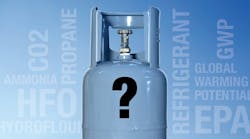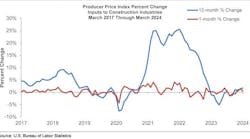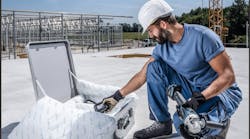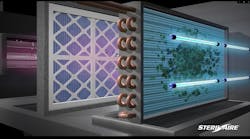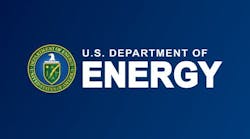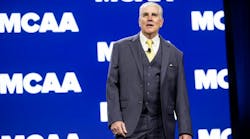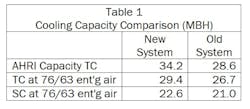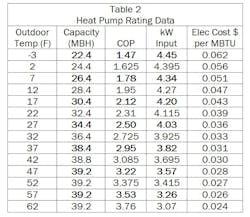By KENNETH M. ELOVITZ, P.E., Energy Economics, Inc.
A recent heat pump conversion raises some valid questions about the economic viability of converting from gas-fired hot water heat to a high-efficiency heat pump.
Existing System
The existing cooling system was a 2½ ton SEER 13 air conditioning unit installed in 2013 with a 2½ ton fancoil unit installed in 1983. The heating system was an 85 AFUE hot water boiler and perimeter baseboard. The motivation for the project was to replace the 40 year old fancoil before it failed.
The new heat pump is a nominal 3-ton, variable speed, SEER 18/SEER2 16 outdoor unit with a nominal 3-ton EC motor fancoil. Table 1 compares the cooling capacities of the new and old units.
Capacity
When selecting any cooling system, it is important to check capacity at job conditions. Here the nominal 20% cooling capacity increase (3 tons/2½ ton) is only an 8% increase in space sensible cooling capacity. That small increase is accompanied by a potentially beneficial 19% latent cooling (dehumidification) capacity increase.
In many cases, especially in colder climates, a system sized to meet the cooling load will not meet the heating load. In a retrofit, retaining the gas- or oil-fired system to supplement the heat pump during cold weather could be advantageous. This arrangement is often called a "hybrid" system.
Upsizing the heat pump to meet 100% of the heating load can have drawbacks. If the system is oversized for cooling, it will not dehumidify well and will tend to short cycle. Remember that peak load occurs only a few hours per year. Therefore, even a properly sized system operates at part load most of the time. Aside from cooling performance considerations, up sizing the heat pump increases first cost for the new equipment. The larger unit might also require a larger electric circuit, adding cost and increasing the scope of the project.
A hybrid system that keeps the existing fuel-fired system might offer the added advantage of being able to power the heating system from a much smaller standby generator.
Operating Cost
Table 2 presents the replacement heat pump capacity and efficiency ratings.
Notes:
- Capacity based on 1040 CFM, 65F entering air (indoors);
- Electric cost based on $0.165/kWh for local distribution company plus $0.145/kWh generation charge (actual costs in 2023-2024);
- Cost/MBTU is cost/kWh * kW input/MBH capacity;
- Bold data are published; others are interpolated or calculated.
Gas heat cost is based on $2.20/therm (actual cost for January-and Februayr-2023) and 78% efficiency. ($2.20/therm)/0.78 efficiency = $2.82/10^5 BTU delivered or $0.028/MBTU delivered. 78% efficiency is a slight tilt toward the heat pump because the boiler is rated 85 AFUE. $2.20/therm consists of $0.98/therm for the commodity plus $1.22/therm for local distribution.
With the cost for gas heat at $0.028/MBTU delivered, the heat pump costs less to operate only when the outdoor temperature is in the 52F bin and above.
Analyzing gas bills from 2017 - 2021 with the technique described in "Analyzing Building Energy Use" (HPAC September 2013) identified a heating load of 0.733 MBH/F temperature difference. For that heating load, Table 3 shows that heat pump heating potentially saves $21/year in energy costs. Those savings accrue during the 2210 hours/year above 50F outdoors when the heat pump costs no more per BTU than gas hot water. Those savings are partly offset by the 15 watts (0.1 amps) the heat pump draws when it is idle.
Electric bill analysis shows the property used approximately 600 kWh for cooling during the summer of 2023. The new 18 SEER system is expected to save...
1-(13 SEER/18SEER) * 600 kWh = 167 kWh or $51/year.
Net first cost of the project after rebates and anticipated tax credits was $6,387.50:
- Contract price $12,950.00;
- Utility rebate (3,562.50);
- Anticipated Federal Income Tax Credit (2,000.00);
- Anticipated State Income Tax Credit* (0.00);
- Net $7,387.50
* not available in Massachusetts
With projected savings on the order of $70/year, the payback would take more than 100 years. Therefore the heat pump conversion did not make sense as a way to reduce operating cost.
The heat pump internal controls have a maximum outdoor temperature changeover point of 40F. If the heat pump were left in automatic mode, it would run for heat in the 42F and 47F bins. Adding those 2 bins to heat pump instead of boiler would increase annual operating cost by $24. That cost increase would negate any heating season operating cost savings from heat pump heating.
As of this writing in January 2024, the supplier (commodity) cost for gas is down $0.25/therm from the $0.98/therm paid in January and February 2023 and used in this analysis. As gas costs go down but electricity costs do not, the economic balance favors the gas boiler even more. Not only are electricity costs not going down, the local electric distribution company requested a 2.2%/year rate increase for the next 5 years.
From mid-January 2023 to mid-January 2024 (latest 12-month period available), the house had the gas and electric use and costs in Table 4.
With gas costs down 12% and electric costs up 5% and continuing to rise, decarbonization appears to be an increasingly unfavorable economic proposition for the rate payer, at least in Massachusetts.
Other Considerations
Variable speed, inverter driven compressors can cause AM radio interference. Manufacturers typically install electric line filters to combat that problem. Despite the presence of the filter, the heat pump caused problematic AM radio interference at startup. Investigation into the potential cause over the next few days revealed that the installer connected the incoming power incorrectly, bypassing the manufacturer-installed noise filter. Rewiring per the diagram on the unit solved the problem.
Unused conductors in thermostat cables can become broadcast antennae and cause radio interference. With the amount of electronic controls in today's equipment, grounding unused leads in thermostat cables is a good practice.
The first time the system came off night setback during cold weather on a call for the boiler, the fancoil fan came on. A simple programming change in the thermostat solved the problem, but the problem did generate a call back. Call backs cost the contractor money and annoy the customer. Installation manuals need more detailed instructions on setting up thermostats and controls for proper integration with other systems.
The thermostat that came with the system defaults to cooling mode after a power failure. That flaw was discovered when a momentary power failure occurred over night, and the house temperature was below 60F when the occupants woke. With the thermostat in cooling mode and the space temperature well below cooling setpoint, the heat did not come on at the end of night setback.
Engineers might want to specify that thermostats must return to their previous operating mode or default to heat after power restoration. That feature is especially valuable in climates where pipes could freeze if a power interruption occurs while the homeowners are away.
####
A longtime member of HPAC Engineering's Editorial Advisory Board, Kenneth M. Elovitz, P.E., Esq., is an engineer (mechanical and electrical) and in-house counsel for Energy Economics, Inc., a consulting engineering firm in Foxboro, MA.


